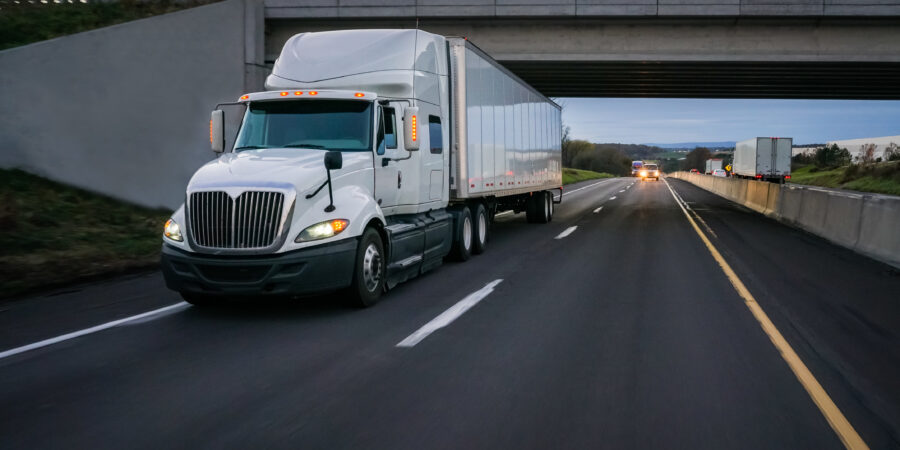Safety Tips for Driving Near Big Rigs
Commercial trucks can weigh up to 10,000 pounds while the average passenger vehicle weighs about 3,000 pounds. Therefore, if you are ever involved in a car accident with a commercial vehicle, there is a good chance that your car will experience significant damage. Fortunately, there are steps that you can take to safely share the road with big rigs and other vehicles that may be larger than your own.
Big Rig Crash Statistics
Data from the National Highway Safety Traffic Administration (NHTSA) indicates that accidents between passenger cars and commercial vehicles make up 3% of all crashes that occur each year. This means that there are roughly 5,000 fatal crashes involving passenger cars and commercial vehicles. Those accidents also cause about 130,000 injuries per year according to the NHTSA, and the vast majority of those who are killed or injured in such accidents are individuals inside of passenger cars or trucks.
Increase Your Following Distance Around Big Rigs
Perhaps the easiest way to avoid getting into an accident with a large truck is to keep your distance from that vehicle. Generally speaking, you are supposed to stay at least three car lengths behind any car that you’re following on the highway.
However, commercial vehicles have stopping distances of about 500 feet compared to roughly 300 feet for a passenger car or truck. Therefore, you’ll want to increase your following distance accordingly when traveling near a big rig.
Following distances tend to be even greater on roads that are covered by snow, rain or other slippery substances. You should also give more room to larger trucks while driving during periods of heavy rain, snow or fog. This is because they lower everyone’s visibility, which leaves less time to react to changing road conditions.
Avoid a Commercial Vehicle’s Blind Spots
If you can’t see the driver of a commercial vehicle, there is a good chance that he or she can’t see your car either. Therefore, that individual may attempt to make a lane change, come to a stop or take other actions assuming that it is safe to do so. You should know that a commercial vehicle’s larger size means that it has larger blind spots.
If possible, you want to put yourself in a spot where you can see the truck’s mirror. This generally means that you aren’t hidden from the driver’s view. In the event that you decide to pass a large truck, make sure to do so as quickly as possible to minimize the amount of time that your car is hidden from view.
Don’t Make Any Sudden Moves
Another reason why you want to stay out of a commercial truck’s blind spot is because it’s much harder for a larger vehicle to take evasive action. For instance, if a truck driver hits the vehicle’s brakes, it’s possible that the truck will jackknife. If this happens, there is a chance that multiple lanes of traffic may be blocked for a significant period of time. It’s also possible that multiple vehicles, people or objects may be struck by the swinging trailer.
Therefore, it’s important to drive as smoothly as possible when you are in the proximity of a commercial vehicle. In addition to making lane changes in a timely and predictable manner, you don’t want to come to a sudden stop unless other vehicles in your vicinity have also come to a sudden stop. If a truck is following you when you unexpectedly slow or stop your car, it’s unlikely that it will be able to avoid colliding with the rear of your car.
Commercial Vehicles Tend to Make Wide Turns
If you see a commercial truck attempting to make a turn, you may want to remain stationary until the maneuver is complete. This is because there is a chance that the truck may veer into your lane while doing so. Therefore, staying where you are may prevent it from swiping the side of your car or truck.
You should also be patient when observing a larger vehicle making a turn on a city street or in other areas where there isn’t a lot of clearance. In most cases, drivers will need more time to make sure that a turn can be made without running over a curb or colliding with other people or objects in its general area.
You Won’t Win a Fight with a Commercial Driver
It may be frustrating following a commercial truck because they tend to be slower than other vehicles on the road. Typically, these vehicles will travel no faster than the posted speed limit for a given area. Combined with the fact that they can be difficult to pass, you may feel incredibly stressed while sharing the highway with a big rig.
However, the last thing that you want to do is make decisions based on emotion as opposed to logic. Ideally, you will never get out of your own car to confront the driver of a larger truck. This is because they are largely protected from almost anything that you might do to harm them. Furthermore, a professional is unlikely to engage with you. Instead, he or she will likely call the police before leaving the scene and letting the authorities deal with you.
If you have any concerns about the way a truck is being operated, call the number listed on the side or back of the vehicle. Alternatively, you can call the police to let them know about any unsafe actions that you have witnessed. Taking these steps can reduce the risk of a car accident or any other events that might endanger your life, a truck driver’s life or others who may be in either vehicle.
What If a Truck Is Being Operated in a Reckless Manner?
While there are many steps that you can take to be a courteous driver, you can’t control what other motorists do. Therefore, it’s important to understand the signs that a commercial driver may be fatigued, under the influence of a controlled substance or is otherwise working in a reckless or unsafe manner.
Perhaps the most common sign of fatigue or impairment is an inability to maintain a single lane. A driver who is falling asleep may have only a loose grip on the steering wheel while an impaired driver may not even be able to tell where one lane ends and another begins.
Other signs of impairment may include braking or changing speeds in an erratic fashion or driving too fast for road conditions. You may also notice that drivers who are under the influence of drugs or alcohol are more aggressive than they should be.
If you notice any of these clues, it may be in your best interest to change lanes, slow down or otherwise stay out of the truck’s path. If possible, you may want to consider pulling over to the side of the road or exiting the highway to put more space between yourself and a dangerous vehicle.
What Should You Do If a Truck Shows Obvious Signs of Damage?
California law requires all vehicles to be properly maintained at all times. If a crash occurs because your car’s tires were underinflated or because your car’s brakes gave out, you could be held liable for damages that others incur. However, in the event that a crash occurs because a commercial vehicle was improperly maintained, the driver of that truck would likely be liable for any damages that you incurred.
Of course, just because someone else may be held responsible for a crash doesn’t mean that you can’t take steps to avoid it. If you see a truck that has bald tires, an improperly attached trailer or other obvious defects, you should get out of that truck’s vicinity as quickly as possible.
You should also call the company that owns the truck to let them know of the violation. This is because it’s possible that a driver doesn’t know that the trailer is open, not properly attached or is otherwise putting others in danger of getting hurt.
What Should You Do If You Get Into an Accident?
If you are involved in a motor vehicle accident, you should call for help and wait for authorities to arrive at the scene. After you have been authorized to leave the scene of the accident, you should seek treatment from your doctor or at a local hospital. An ambulance can take you from the scene of the crash to the hospital if you’re not capable of doing so yourself.
From there, it may be wise to call an attorney who is familiar with California law and how it applies to your case. An attorney may be able to gather witness statements, truck maintenance records and other evidence that might help you obtain a favorable outcome in your proceeding.
Your legal adviser may also file a lawsuit on your behalf the day that he or she is hired. This helps to ensure that the statute of limitations is not allowed to expire, which could impair your ability to hold the defendant accountable for his or her actions.
Hopefully, you will never be involved in an accident with a large truck. However, if you are, it’s important to know and defend your rights throughout the legal process. California law may allow you to obtain compensation for medical bills, lost wages and other damages incurred because of the actions of a negligent truck driver.



